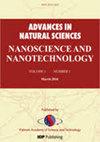利用聚苯胺和掺杂锌的 Fe3O4 纳米复合材料在水中吸收砷的研究
IF 2.1
Q3 MATERIALS SCIENCE, MULTIDISCIPLINARY
Advances in Natural Sciences: Nanoscience and Nanotechnology
Pub Date : 2024-08-27
DOI:10.1088/2043-6262/ad6e5b
引用次数: 0
摘要
采用共沉淀和原位聚合两种方法合成了不同质量比的聚苯胺/Fe2.9Zn0.1O4(PANI/Fe2.9Zn0.1O4)纳米粒子。傅立叶变换红外光谱和 DTA 分析表明,纳米复合材料样品中含有 PANI。用扫描电子显微镜测量的样品晶粒大小为 25 至 40 纳米。当 PANI/Fe2.9Zn0.1O4 的质量比从 9% 增加到 40% 时,样品在 300 K、H = 11000 Oe 条件下的磁化率从 65 降到 43 emu g-1。在 pH 7 和 300 K 条件下,样品 S1(质量比为 9%)的最大砷(III)吸附容量 qmax = 43.48 mg g-1 高于其他样品和 Fe3O4。此外,样品中 Zn2+ 离子取代 Fe2+ 离子以及 PANI 的存在有助于提高样品的磁性和化学稳定性。此外,这些材料在 pH 值为 14 的溶液中解吸后可重复使用。本文章由计算机程序翻译,如有差异,请以英文原文为准。
Study on the nanocomposites of polyaniline and Zn doped Fe3O4 using for arsenic absorption in water
The polyaniline/Fe2.9Zn0.1O4 (PANI/Fe2.9Zn0.1O4) nanoparticles with different mass ratios were synthesized by both co-precipitation and in situ polymerization methods. The FT-IR spectra and DTA analyses showed the involvement of PANI in the nanocomposite samples. The grain size of samples measured by SEM ranges from 25 to 40 nm. The magnetization of samples at 300 K, H = 11000 Oe decreased from 65 to 43 emu g−1 as PANI/Fe2.9Zn0.1O4 mass ratio increased from 9% to 40%. At pH 7 and 300 K, the maximum arsenic (III) adsorption capacities of sample S1 (mass ratio of 9%) qmax = 43.48 mg g−1 was higher than that of others and Fe3O4. Additionally, the substitution of Fe2+ ions by Zn2+ ions and the presence of PANI in samples contributed to improving the magnetic and chemical stability of samples over time. Furthermore, these materials could be reused after desorption in a solution at pH 14.
求助全文
通过发布文献求助,成功后即可免费获取论文全文。
去求助
来源期刊

Advances in Natural Sciences: Nanoscience and Nanotechnology
NANOSCIENCE & NANOTECHNOLOGYMATERIALS SCIE-MATERIALS SCIENCE, MULTIDISCIPLINARY
自引率
4.80%
发文量
0
 求助内容:
求助内容: 应助结果提醒方式:
应助结果提醒方式:


